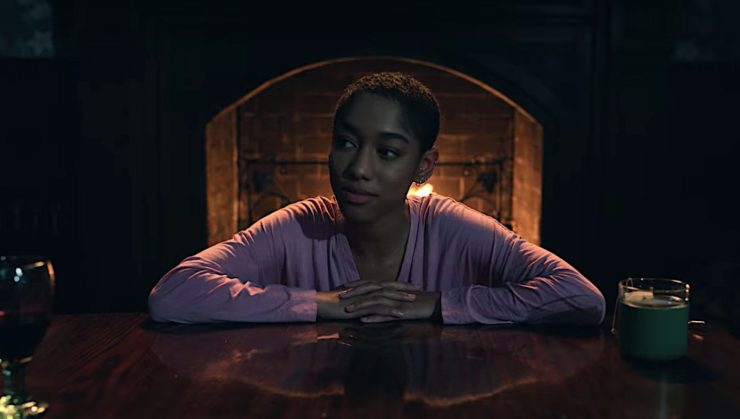The Midnight Club was created by Mike Flanagan, and is very much part of the Flanaverse in tone and execution. But this outing was co-created with Leah Fong, a writer who previously worked with Flanagan as a writer and producer for Haunting of Bly Manor, as well as writing for The Magicians and Once Upon a Time. What I’ll say immediately is that this is a very good show. Every character is complex and fully alive, the acting is gorgeous, and the stories-within-the-story are fantastic. But this show wasn’t quite what I was expecting, and I’ll try to get into that below.
As usual for reviews of longer series, I’m going to give a brief overview, a few opinions, a well-marked spoiler section for discussion, and then, hopefully, stick the landing at the end. If you want to go into Midnight Club cold, click away now!
For the rest of you, an opening caveat: I’m not entirely sure The Midnight Club is horror. If you know Mike Flanagan’s other work: where Doctor Sleep and Ouija: Origin of Evil are both solid entries in established horror series, where Hill House and Bly Manor are both ghost stories about processing grief, and Midnight Mass is supernatural horror that processes religious trauma (and the trauma of watching Salem’s Lot as a kid), Midnight Club is much more a drama—an often dark, upsetting drama—that’s informed by the horror genre, and dotted with horror moments that might be supernatural.
Having said that, it’s very good, just not quite what I was expecting.
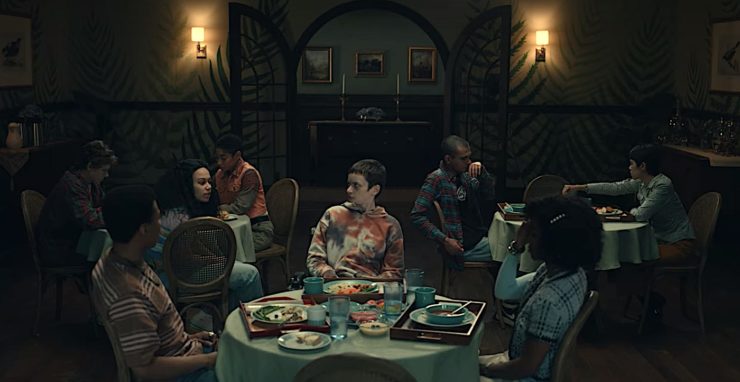
On a certain level this show is ten hours of watching kids die while they tell stories to try to ward off the dark, so again, depending on how you respond to illness and grief this might be your favorite thing ever or you might throw your remote through the television screen. My guess, having dealt closely with cancer but not having had it myself, is that people who have it or have had it will probably like this show. The kids are tough and vulnerable and absolutely lovable, and the show takes a very no-bullshit approach to illness that I appreciated. If you’re mourning someone, first of all I’m sorry, and secondly you might not want to do this show yet. If I hadn’t been reviewing it I might have noped out at a couple points—not because of anything gratuitous, but simply because the characters are so real, and their pain is so real, that it’s kind of tough to watch.
And having said that, the characters are all great, and the acting is stellar across the board (with a special shout to Ruth Codd in her first professional role, cause holy shit). The ’90s nostalgia porn is just about perfect. As ever with Flanagan the sense of place is strong, I don’t know if Brightcliffe quite reaches the atmospheric heights of Hill House or Bly Manor, but the library and the spooky old-timey elevator go a long way.
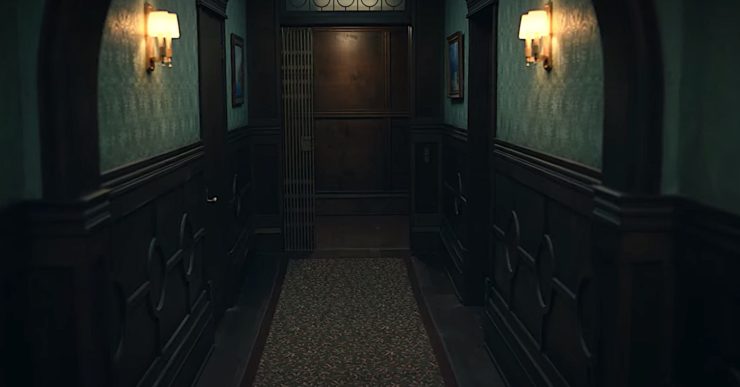
Our characters are: Ilonka (Iman Benson), Anya (Ruth Codd), Spence (Chris Sumpter), Kevin (Igby Rigney), Sandra (Annarah Cymone), Natsuki (Aya Furukawa), Cheri (Adia), and Amesh (Sauriyan Sapkota). Rather than falling into the cliques or stereotypes so beloved of ’80s and ’90s teen media, they’re categorized by type of cancer—though to be honest the show doesn’t go into too much detail about how the different cancers hit them. One character has a PICC line and poor motor function, a couple of them puke at night, everyone’s on a different drug cocktail, and everyone is visibly tired most of the time. I was of two minds on this—the point of Brightcliffe is that the kids have come for palliative care, they’re all on their way out, they know it, so there’s no chemo or radiation therapy at this point. At the same time, they did seem to have a bit too much energy for people who were in the final stages of cancer? But then, shouldn’t people get to be the heroes of their stories even up to the last minute?
Ilonka is our protagonist, smart, driven, and a bit of a magical thinker. Anya is, well, perfect: a furious Irish bitch who attacks the world with sarcasm, and only lets her depth of feeling show when she’s tearing someone’s head off on behalf of a friend. Kevin is the golden boy who only lets his dark side out in gallows humor, Sandra is a sweet Jesus Freak, Spence, (the leader, as much as the group has one) is a walking bomb of charisma, Amesh would be the “nerd” on a different type of show, Cheri is very rich and very lonely, and Natsuki is a punk whose wrestling match with depression is about as intense as the one she’s in with cancer. They’re watched over by a Nurse Practitioner Mark (Zach Gilford, last seen in the Flanaverse being emotionally devastating as Riley in Midnight Mass) and the founder of Brightcliffe, Dr. Georgina Stanton (Heather fucking Langenkamp, who is amazing in a bunch of different roles here.) Fans of Mike Flanagan’s work (Flanafans? Fanagans?) will be happy to hear that Rahul Kohli shows up and is reliably brilliant—though I wanted more of him—and Samantha Sloyan knocks her role out of the park once again.
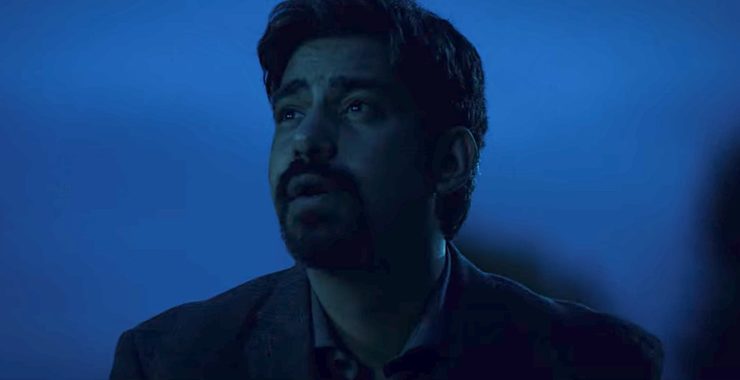
The ’90s nostalgia here is impeccable. Ilonka gets ready for a party by Manic Panic-ing her hair and pairing a long flower dress with stompy Docs. When we meet Amesh he’s wearing a baggy black T-shirt printed with a Jesus fish that loops around the word “LOSER”. A queer activist collective has decorated their walls with posters for Arrested Development’s first album and Rattle and Hum—so you know they’re serious. VCRs cost $200. (tbf they probably cost that much again.) When a character excitedly tells another about Interview with the Vampire, he can’t remember the name of the guy who plays Armond, because Antonio Banderas wasn’t a household name yet. The music is actually accurate, in that it’s full of songs that were actually on the radio, not just over-curated hits. When one kid goes to prom, of course Duran Duran’s “Ordinary World” is playing on the car radio. Obviously House of Pain’s “Jump Around” is blasting at a college party (obligatory mumble of “fuck me I’m Irish”) and naturally it’s followed up with “Insane in the Membrane”. The only segment that feel curated music-wise, is Natsuki’s story, “Road to Nowhere”—and that’s because Natsuki is a punk with stellar taste, so her story is soundtracked with The Pixies and L7 and Soundgarden’s best song. One of the kids wants Radiohead to be the soundtrack to his funeral (same) and one knows how to play “Good Riddance” on the cello, but the one that really knocked me sideways was a perfectly deployed needledrop of “Hazard” by Richard Marx. Chef’s kiss, show.
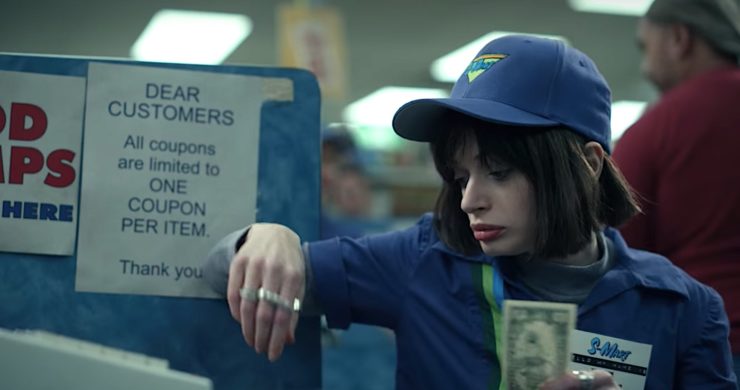
The kids go through days of group therapy, med cycles, bickering and flirting with each other. But the axis point of their day comes at midnight, when they tell each other stories around a table in the library. The stories draw from Christopher Pike’s work and provide episode titles (Gimme a Kiss, Road to Nowhere, The Wicked Heart, etc.) and they’re amazing. They range from stories of loving witches to possessed serial killers to detective dramas to deals with the Devil, each story refracting some corner of the teller’s life. The kids, quite believably, cast each other as characters, and the great joy of The Midnight Club is watching the actors embody totally different personalities as each story demands. (Dr. Stanton shows up whenever they need an adult authority.) Some of the stories are also really funny, as when Sandra tells a noir-ish detective story without any swearing or smoking, and with only the barest hint of sex as she tries to shock the kids without betraying her Christian values. Some of the stories comment on fights the kids are having with each other, some are attempts to process past traumas, regrets, and homophobia. All of them deal with death, a lot—it’s the very visible and acknowledged elephant in the room. And they’re believably stories being told by kids, full of movie references, posters and music that are presumably being described in great detail, and, whenever things go off the rails, interruptions and commentary from the audience. In a very dark show, they’re fun as heck. One episode in the center of the series is especially jarring, and knocks the wind out of the story for a while. That’s good, because the story is heartbreaking and needs to have that weight, but it also feels a bit like we’re being thrown back against our seats as the brakes catch, if that makes sense.
I’m still mulling my responses to the show. I don’t think I’m quite as over-the-moon for this one as I was with Midnight Mass. It might be that the pacing didn’t entirely work for me. The possible supernatural elements are doled out in odd, intermittent burst, and often just as quickly shown to have rational explanations. And I want to be clear, here: I don’t mean the thread of faith vs. science that runs through the show. I’m all for that, and I think the show does a great job of showing a spectrum of people who are reacting to their mortality in a variety of ways. The kids who are religious are treated with as much respect as the ones who are not. What the show pushes back against is quackery. But what I’m pointing out is that by applying that by showing us traditional haunted house tropes, and then undercutting them, the show created a sense of tension for me that was quite different than my usual relationship to horror—it was more like I was waiting for each ghost to be debunked because I didn’t want to be fooled again.
But to talk about this in any depth I’ll get into some spoilers, so split if you need to.
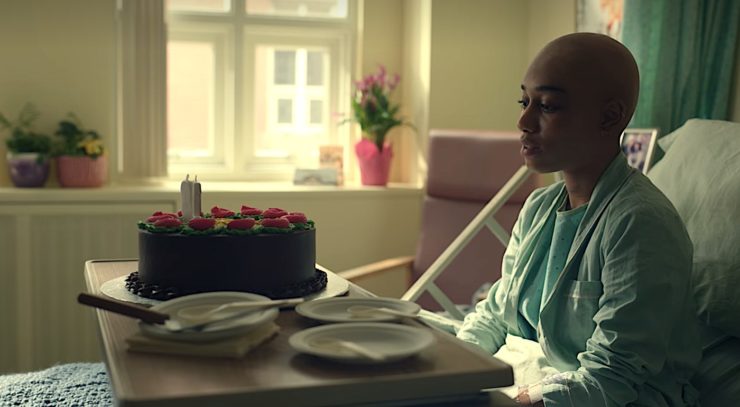
Throughout the show there are hints that something is “wrong” with Brightcliffe, a cult used to lived there, and that Stanton is hiding something. There’s a story about a woman named Julia Jayne, who somehow found a miracle cure for the same type of cancer Ilonka has—is this true, or just a hopeful rumor? Ilonka seems to have visions of her future at Brightcliffe while she’s researching it, and we see a black shadow chasing some of the patients. Ilonka and Kevin both see ghostly elderly people. Ilonka occasionally falls into the past, where the hallways are lit by candles, old timey music plays, and Brightcliffe suddenly looks like a Bioshock cutscene. These supernatural elements are peppered across the show, but my (slight) problem is that they don’t seem to add up to anything. (At least not yet.) Ilonka’s visions come true…kind of. The show constantly vacillates between “the black shadow is a real thing” and “the black shadow is the kids’ fear of death personified”. Are the hallucinations just happening because everyone’s on pretty strong medical cocktails? Maybe! And that’s great up to a point. Good psychological horror has to walk that line, and obviously Flanagan’s earlier Netflix shows have done so very well—but at a certain point I started to feel like I was being ghostbaited. And then, after nine hours of being shown things that seemed supernatural only to have them all explained away, the very last episode gives us at least three giant hints that Ilonka’s been right all along: there are supernatural forces at work at Brightcliffe, and Stanton is not what she seems. As an on-ramp for Season Two I get it, but it also felt a little…last minute? After all that systematic debunking, seeing three more uncanny moments felt a little exhausting. (But full disclosure: one of those uncanny things made me cry.)
As for other spoiler-y stuff: I thought the way the show dealt with homophobia in Spence’s arc was good. Seeing Spence navigate 1995 as a gay man with AIDS was interesting—the writers did a good job of showing how isolated he is, and how even well-meaning people react with fear and pity when they hear about his diagnosis, and even cancer patients look askance at a person with AIDS. But in the midst of that the kids themselves make Brightcliffe a safe place for Spence, and when he tells a story it has a completely matter-of-fact romance in it. Two young men go on what’s obviously a date in a sports bar—a thing that’s a bit unlikely for 1995. But also, this is Spence’s story. And he can tell it like that, to his friends, with no gay-bashing or anything, because he’s safe with them in the library. Given that (some) queerness is accepted in the U.S. at a level I never expected to see in my lifetime, I appreciated that the writers tried to show how much harder queer life was back then, but also show us queer joy. At the same time, after all the progress we made, we’re seeing a horrifying backlash against trans lives at every level of society—even among the queer community—so I can only hope that kids watching Midnight Club take in its pretty accurate take on the 90s, and see how recently the progress was made, and how easy it will be to lose it.
I also really loved Natsuki’s standout episode, when she tells a story of a confused young woman who goes on a roadtrip and ends up with a pair of hitchhikers who may not have her best interests at heart. The way the writers handle her depression is nuanced and, I thought, extremely realistic. I really loved the idea that, yes, she has cancer, but rather than wiping the slate clean she still has to contend with a different kind of chronic illness, every day. They are two separate facts in her life, and she has to figure out how to negotiate both of them.
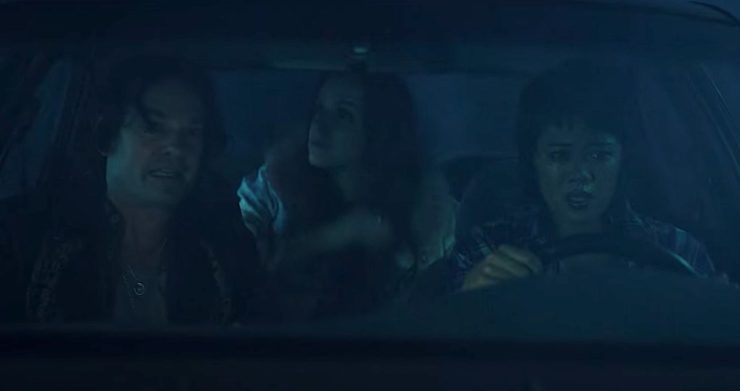
OK I’ll cut it out with the spoilers now.
If the show is at times bleak, it’s also a beautiful, nuanced look at friendship…or really more than that. Just saying friendship doesn’t capture it. One of the hallmarks of the ‘90s was a sudden emphasis on “found families.” From Spaced to Living Single to Buffy to Party Girl, to Full House, even, kind of, the idea that a group of people could come together and form bonds that were a different shape than a traditional nuclear family became extremely popular. (If you’re willing to follow me out on a limb, I think this might have been an echo of activist collectives and queer chosen families that grew up to fight Reagan-and-Thatcher-ism in the ‘80s, but I can’t back that up yet.) That is what The Midnight Club gets so right, and what becomes the show’s greatest strength. In the face of the bleakest circumstances imaginable, a group of teens comes together not to fight monsters, and not (only) to tell stories, but to support each other in the face of death.
The Midnight Club is a beautifully written and acted series, deeply emotionally involving, and occasionally heartbreaking. It wasn’t quite what I expected, but I’m glad I watched it, and I think it’s a great addition to the Flanaverse, and a fantastic first entry in what I hope will be the Fongverse.










